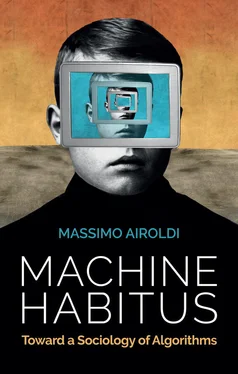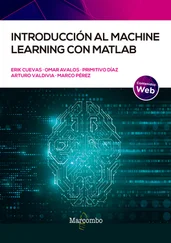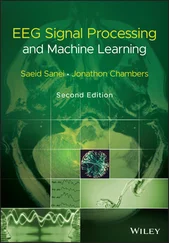More generally, algorithms can be intended as computational recipes, that is, step-by-step instructions for transforming input data into a desired output (Gillespie 2014). According to Gillespie (2016: 19), algorithms are essentially operationalized procedures that must be distinguished from both their underlying ‘model’ – the ‘formalization of a problem and its goal, articulated in computational terms’ – and their final context of application, such as the technical infrastructure of a social media platform like Facebook, where sets of algorithms are used to allocate personalized content and ads in users’ feeds. Using a gastronomic metaphor, the step-by-step procedure for cooking an apple pie is the algorithm, the cookbook recipe works as the model, and the kitchen represents the application context. However, in current public and academic discourse, these different components and meanings tend to be conflated, and the term algorithm is broadly employed as a synecdoche for a ‘complex socio-technical assemblage’ (Gillespie 2016: 22).
‘Algorithm’ is thus a slippery umbrella term, which may refer to different things (Seaver 2017). There are many kinds of computational recipes, which vary based on their realms of application as well as on the specific ‘algorithmic techniques’ employed to order information and process data (Rieder 2020). A single task, such as classifying texts by topic, may concern domains as diverse as email ‘spam’ filtering, online content moderation, product recommendation, behavioural targeting, credit scoring, financial trading and more – all of which involve a plethora of possible input data and outputs. Furthermore, text classification tasks can be executed in several – yet all ‘algorithmic’ – ways: by hand, with pen and paper only; through rule-following software applying models predefined by human programmers (e.g. counting topic-related word occurrences within texts); or via ‘intelligent’ machine learning systems that are not explicitly programmed a priori. These latter can be either supervised – i.e. requiring a preliminary training process based on data examples, as in the case of naive Bayes text classifiers (Rieder 2017) – or unsupervised , that is, machine learning techniques working without pre-assigned outputs, like Latent Dirichlet Allocation in the field of topic modeling (Bechmann and Bowker 2019).
This book does not aim to offer heavily technical definitions, nor an introduction to algorithm design and AI technologies; the reader can easily find such notions elsewhere. 2Throughout the text, I will frequently make use of the generic terms ‘algorithm’ and ‘machine’ to broadly indicate automated systems producing outputs based on the computational elaboration of input data. However, in order to highlight the sociological relevance of the quali-quantitative transition from Euclid’s calculations to today’s seemingly ‘intelligent’ artificial agents like GPT-3 and AlphaGo, some preliminary conceptual distinctions are needed. It is apparent, in fact, that the everyday socio-cultural implications of algebraic formulas solved for centuries by hand or via mechanical calculators are not even close in magnitude to those of the algorithms currently governing information networks.
Below I briefly outline the history of algorithms and their applications – from ancient algebra to rule-following models running on digital computers, and beyond to platform-based machine learning systems. This socio-technical evolution can be roughly broken into three main eras , visually summarized in Figure 1at the end of this section. Without pretending to be exhaustive, the proposed periodization focuses especially on the emergence of ‘public relevance algorithms’ (Gillespie 2014: 168), that is, automated systems dealing with the social matter of human knowledge, experience and practice.
Taking analogue to mean ‘not-digital’ (Sterne 2016), this first historical phase ranges in principle from the invention and manual application of algorithms by ancient mathematicians to the realization of the first digital computers right after the Second World War. Within this period, algorithms were applied either by human-supervised mechanical devices or by humans themselves (Pasquinelli 2017). In fact, up until the early twentieth century, the word ‘computer’ indicated a person employed to make calculations by hand. Mechanical computers started to be conceptualized at the beginning of the nineteenth century, following Leibniz’s early intuitions about the mechanization of calculus (Chabert 1999), as well as a rising demand for faster and more reliable calculations from companies and governments (Wilson 2018; Campbell-Kelly et al. 2013). Aiming to automatize the compilation of tables for navigation at sea, particularly strategic for the British Empire, in the 1820s the mathematician Charles Babbage designed the first mechanical computer, the Difference Engine, which was then followed by the more ambitious Analytical Engine – ideally capable of performing ‘any calculation that a human could specify for it’ (Campbell-Kelly et al. 2013: 8). Babbage’s proto-computers were pioneering scientific projects that remained largely on paper, but more concrete applications of simpler electro-mechanical ‘algorithm machines’ (Gillespie 2014) came to light by the end of the century. In 1890, Hollerith’s electric tabulating system was successfully employed to process US census data, paving the way for the foundation of IBM. Thanks to the punched-card machines designed by Hollerith, information on over 62 million American citizens was processed within ‘only’ two and a half years, compared with the seven years taken by the previous census, with an estimated saving of 5 million dollars (Campbell-Kelly et al. 2013: 17–18). The mass production of desk calculators and business accounting machines brought algorithms closer to ordinary people’s everyday routines. Still, information was computationally transformed and elaborated solely through analogue means (e.g. punched cards, paper tapes) and under human supervision.
Through the 1930s and the 1940s, a number of theoretical and technological advances in the computation of information took place, accelerated by the war and its scientific needs (Wiener 1989). The Harvard Mark I became the ‘first fully automatic machine to be completed’, in 1943. However, it was still ‘programmed by a length of paper tape some three inches wide on which “operation codes” were punched’ (Campbell-Kelly et al. 2013: 57). The pathbreaking conceptual work of the British mathematician Alan Turing was crucial to the development of the first modern electronic computer, known as ENIAC, in 1946. It was a thousand times faster than the Harvard Mark I, and finally capable of holding ‘both the instructions of a program and the numbers on which it operated’ (Campbell-Kelly et al. 2013: 76). For the first time, it was possible to design algorithmic models, run them, read input data and write output results all in digital form, as combinations of binary numbers stored as bits. This digital shift produced a significant jump in data processing speed and power, previously limited by physical constraints. Algorithms became inextricably linked to a novel discipline called computer science (Chabert 1999).
With supercomputers making their appearance in companies and universities, the automated processing of information became increasingly embedded into the mechanisms of post-war capitalism. Finance was one of the first civil industries to systematically exploit technological innovations in computing and telecommunications, as in the case of the London Stock Exchange described by Pardo-Guerra (2010). From 1955 onwards, the introduction of mechanical and digital technologies transformed financial trading into a mainly automated practice, sharply different from ‘face-to-face dealings on the floor’, which had been the norm up to that point.
Читать дальше












